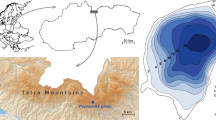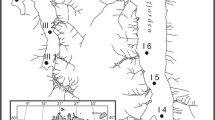Abstract
Diatoms were analysed from a 30-cm long sediment core obtained from remote subarctic Lake Saanaärvi (69°03′N, 20°52′E) in order to trace possible changes in the lake. Diatom assemblages were relatively constant throughout the core, except in the top 4–5 cm (approx 1850 A.D.) where relative frequencies of Aulacoseira italica subsp. subarctica, A. lirata var. biseriata, Cyclotella comensis and C. glomerata increased markedly. No significant trends were observed in the weighted averaging (WA) reconstructed pH values. Several hypotheses, including (i) airborne pollution, (ii) climatic change, and (iii) catchment disturbances have been put forth to explain the recent changes in diatom assemblages. The diatom change coincides with a marked increase in mean annual temperature that has been documented in the area since the termination of the Little Ice Age. Our evidence favours climate change as the main causative mechanism for the observed diatom compositional changes, although other explanations cannot be ruled out.
Similar content being viewed by others
References
Alexandersson, H. & B. Eriksson, 1989. Climate fluctuations in Sweden 1860—1987. SMHI reports Meteorology and Climatology 58: 1–54.
Anderson, N. J., 1990. Variability of diatom concentrations and accumulation rates in sediments of a small lake basin. Limnol. Oceanogr. 35: 497–508.
Anderson, N. J., P. Blomqvist & I. Renberg, 1997. An experimental and palaeoecological study of algal responses to lake acidification and liming in three central Swedish lakes. E. J. Phycol. 328: 35–48.
Atlas of Finland, 1986. Geology, Folio 123–126. National Board of Survey, Geographical Society of Finland.
Birks, H. J. B., 1995. Quantitative palaeoenvironmental reconstructions. In D. Maddy & J. S. Brew (eds), Statistical modelling of Quaternary science data. Quat. Res. Assoc., Cambridge: 161–254.
Bradbury, J. P., 1988. A climatic limnologic model of diatom succession for paleolimnological interpretation of varved sediments at Elk lake, Minnesota. J. Paleolimnol. 1: 115–131.
Bradbury, J. P. & K. V. DieterichRurap, 1993. Holocene diatom paleolimnology of Elk Lake, Minnesota. In J. P. Bradbury & W. E. Dean (eds), Elk Lake, Minnesota: Evidence for rapid climate change in the northcentral United States. Geological Society of America Special Paper 276. Boulder: 215–237.
Cameron, N. G., 1995. The representation of diatom communities by fossil assemblages in a small acid lake. J. Paleolimnol. 14: 185–223.
Dean, W. E., 1974. Determination of carbonate and organic matter in calcareous sediments and sedimentary rocks by loss on ignition: comparison with other methods. J. sed. Petrol. 44: 242–248.
Douglas, M. S. V., J. P. Smol & W. Blake Jr, 1994. Marked post18th century environmental change in higharctic ecosystems. Science 266: 416–419.
Douglas, M. S. V. & J. P. Smol, in press. Freswater diatoms as indicators of environmental change in the High Arctic. In press in: Stoermer, E. F. & J. P. Smol (eds). The Diatoms: Applications to the Environmental and Earth Sciences. Cambridge University Press, Cambridge.
Doskey, P. V. & B. J. Ugoagwu, 1989. Atmospheric deposition of macronutrients by pollen at a semiremote site in northerm Wisconsin. Atmosph. Environ. 12: 2761–2766.
Hartley, B., 1986. A checklist of the freshwater, brackish and marine diatoms of the British Isles and adjoining coastal waters. J. Brit. Mar. Biol. Ass. 66: 531–610.
Haworth, E. Y., 1988. Distribution of diatom taxa of the old genus Melosira (now mainly Aulacoseira) in Cumbrian waters. In F. E. Round (ed.), Algae and the Aquatic Environment. Biopress, Bristol: 138–167.
Haworth, E.Y. & M. A. Hurley, 1984. Comparison of the stelligeroid taxa of the centric diatom genus Cyclotella. Proceedings of the 8th International Diatom Symposium, 43–58.
Haworth, E. Y., K. M. Atkinson & P. S. Newell, 1986. Distribution of certain diatom taxa in the waterbodies of Cumbria, U.K. Proceedings of the 9th International Diatom Symposium, Bristol, August 24—30: 17–28.
Heino, R., 1994. Climate in Finland during the period of meteorological observations. Finnish Meteorological institute Contributions 12. Finnish Meteorological Institute, Helsinki.
Hondzo, M. & H. G. Stefan, 1993. Regional water temperature characteristics of lake subjected to climate change. Climatic Change 24: 187–211.
Houghton, J. T., G. J. Jenkins & J. J. Ephraums (eds), 1990. Climate Change: the IPCC Scientific Assessment. Cambridge University Press, Cambridge.
Järvinen, A., 1987. Basic climatological data on the Kilpisjärvi area, NW Finnish Lapland. Kilpisjärvi Notes 10: 1–16.
Korhola, A., 1996. Northern lakes as key witnesses for climatic change. Universitas Helsingensis 3: 16–19.
Korhola, A., J. Virkanen, M. Tikkanen & T. Blom, 1996. Fire induced pH rise in a naturally acid hilltop lake, southern Finland: a palaeoecological survey. J. Ecol. 84: 257–265.
Koster, E. A., 1994. Global Warming and Periglacial Landscapes. In N. Roberts (ed.), The Changing Global Environment. Blackwell, Cambridge 127–149.
Krammer, K. & H. Lange-Bertalot, 1991. Bacillariophyceae. 3. Teil: Centrales, Fragilariaceae, Eunotiaceae. In H. Ettl, J. Gerloff, H. Heynig & D. Mollenhauer (eds), Süsswasserflora von Mitteleuropa. Gustav Fischer Verlag, Stuttgart.
Livingstone, D.& A. F. Lotter, 1997. The correspondence of modern air temperature and surface water temperature in lakes of the Swiss Plateau: a case study with paleolimnological implications. J. Paleolimnol. (in press.)
Lotter, A. F. & S. Juggins, 1991. POLPROF, TRAN and ZONE: Programs for plotting, editing and zoning pollen and diatom data. INQUA Comm. study Holocene, Working Group on Data Handling Methods Newsletter 6: 4–6.
Lien, L., A. Henkirsen & T. S. Traaen, 1993. Critical load of acidity to surface waters — Svalbard. Rep. O90102/ Norwegian Institute for Water Research.
Lee, J. E, N. Kenkel & T. Booth, 1996. Atmospheric deposition of macronutriens by pollen in the boreal forest. Écoscience 3: 304–309.
Moser, K. A., 1996. A limnological and paleolimnological investigation of lakes in Wood Buffalo National Park, Northern Alberta and the Northwest Territories, Canada. Ph.D. Thesis. Department of Geography, McMaster University, Canada.
Moser, K, G. M. MacDonald & J. P. Smol, 1996. Applications of freshwater diatoms to geographical research. Prog. Phys. Geogr. 20: 21–52.
MOLAR, 1997. Summary of the diatom taxonomic workshop in Helsinki, October 18—19, 1996 by Cameron, N., K. Koinig, A. F. Lotter, S. Sorvari & J. Weckström. In: Wathne B. (ed.), MOLAR Progress Report 1996—1997. Norwegian Institute for Water Research, Report SNO 371097.Oslo.
Nyman. M. T. & A. A. Korhola, submitted. Diatom records from small lakes close to the emisson sources of the Kola Peninsula (Russia) suggest surprising resistance of arctic ecosystems to atmospheric contamination.
Pienitz, R., J. P. Smol & H. J. B. Birks, 1995. Assesment of freshwater diatoms as quantitative indicators of past climatic change in Yukon and Northwest Territories, Can. J. Paleolimnol. 13: 21–49.
Prentice, I. C., 1980. Multidimensional scaling as a research tool in Quaternary palynology: a review of theory and methods. Rev. Palaeobot. Palynol. 31: 71–104.
Rawlence, D. J. & A. Senior, 1988. A late Glacial diatom and pigment history of Little Lake, New Brunswick with particular reference to the Younger Dryas climatic oscillation. J. Paleolimnol. 1: 163–177.
Renberg, I., T. Korsman & H. J. B. Birks, 1993. Prehistoric increases in the pH of acidsensitive Swedish lakes caused by land-use changes. Nature 362: 824–827.
Rose, N. L., 1995. Carbonaceous particle record in lake sediments from the Arctic and other remote areas of the Northern Hemisphere. Sci. Tot. Envir. 160/161: 487–496.
Round, F. E., R. M. Crawford & D. G. Mann, 1990. The Diatoms. Biology & Morphology of the Genera. Cambridge: Cambridge University Press.
Rouse, W. R., M. Douglas, R. Hecky, G. Kling, L. Lesack, P. Marsh, M. McDonald, B. Nicholson, N. Roulet & J. Smol, 1997. Effects of climate change on fresh waters of Region 2: Arctic and Subarctic North America. Hydrol. Proc. 11: 873–902.
Rühling, È. (ed.), 1992. Atmospheric heavy metal deposition in northern Europe 1990. Nord 1992: 12. Nordic Council of Ministers, Copenhagen.
Smol, J. P., 1988. Paleoclimate proxy data from freshwater arctic diatoms. Verh. int. Ver. Limnol. 23: 837–844.
Smol, J. P., L. R. Walker & P. R. Leavitt, 1991. Paleolimnology and hindcasting climatic trends. Verh. int. Ver. Limnol. 24: 1240–1246.
Smol, J. P., B. F. Cumming, M. S. V. Douglas & R. Pienitz, 1995. Inferring past climatic changes in Canada using paleolimnological techniques. Geosci. Canada 21: 113–118.
ter Braak, C. J. F. (1988). CANOCO — a FORTRAN program for canonical community ordination by [partial] [detrended] [canonical] correspondence analysis, principal components analysis and redundancy analysis (version 2.10). Agricultural Mathematics Group Technical Report LW-A88-02. Wageningen: Agricultural Mathematics Group, 95 pp.
ter Braak, C. J. F. (1990). Update notes: CANOCO version 3.10. Wageningen: Agricultural Mathematics Group, 35 pp.
Tuomenvirta, H., 1995. The warmest decade in Finland, 1930s. In P. Heikinheimo (ed.), International Conference on Past, Present and Future Climate. Proceedings of the SILMU conference held in Helsinki, Finland, 22—25 August 1995. Publications of The Academy of Finland 6/95, 258–261.
Tuomenvirta, H. & R. Heino, 1996. Climatic changes in Finland—recent findings. Geophysica 32: 61–75.
Tuovinen, J-P., T. Laurila, H. Lättilä, A. Ryaboshapko, P. Brukhanov & D. S. Korolev, 1993. Impact of the sulphur dioxide sources in the Kola Peninsula on air quality in northernmost Europe. Atmos. Envir. 9: 1379–1395.
Weckström, J., A. Korhola & T. Blom, 1997a. The relationship between diatoms and water temperature in 30 subarctic Fennoscandian lakes. Arc. Alp. Res. 29: 75–92.
Weckström, J., A. Korhola & T. Blom, 1997b. Diatoms as quantitative indicators of pH and water temperature in subarctic Fennoscandian lakes. Hydrobiologia 347: 171–184.
Wilson, S. E., I. R. Walker, R. J. Mott & J. P. Smol, 1993. Climatic and limnological changes associated with the Younger Dryas in Atlantic Canada. Climate Dyn. 8: 177–187.
Wunsam, S., R. Schmidt & R. Klee, 1995. Cyclotella-taxa (Bacillariophyceae) in lakes of the alpine region and their relationship to environmental variables. Aquat. Sci. 57: 360–386.
Author information
Authors and Affiliations
Rights and permissions
About this article
Cite this article
Sorvari, S., Korhola, A. Recent diatom assemblage changes in subarctic Lake Saanajärvi, NW Finnish Lapland, and their paleoenvironmental implications. Journal of Paleolimnology 20, 205–215 (1998). https://doi.org/10.1023/A:1007953515620
Issue Date:
DOI: https://doi.org/10.1023/A:1007953515620




